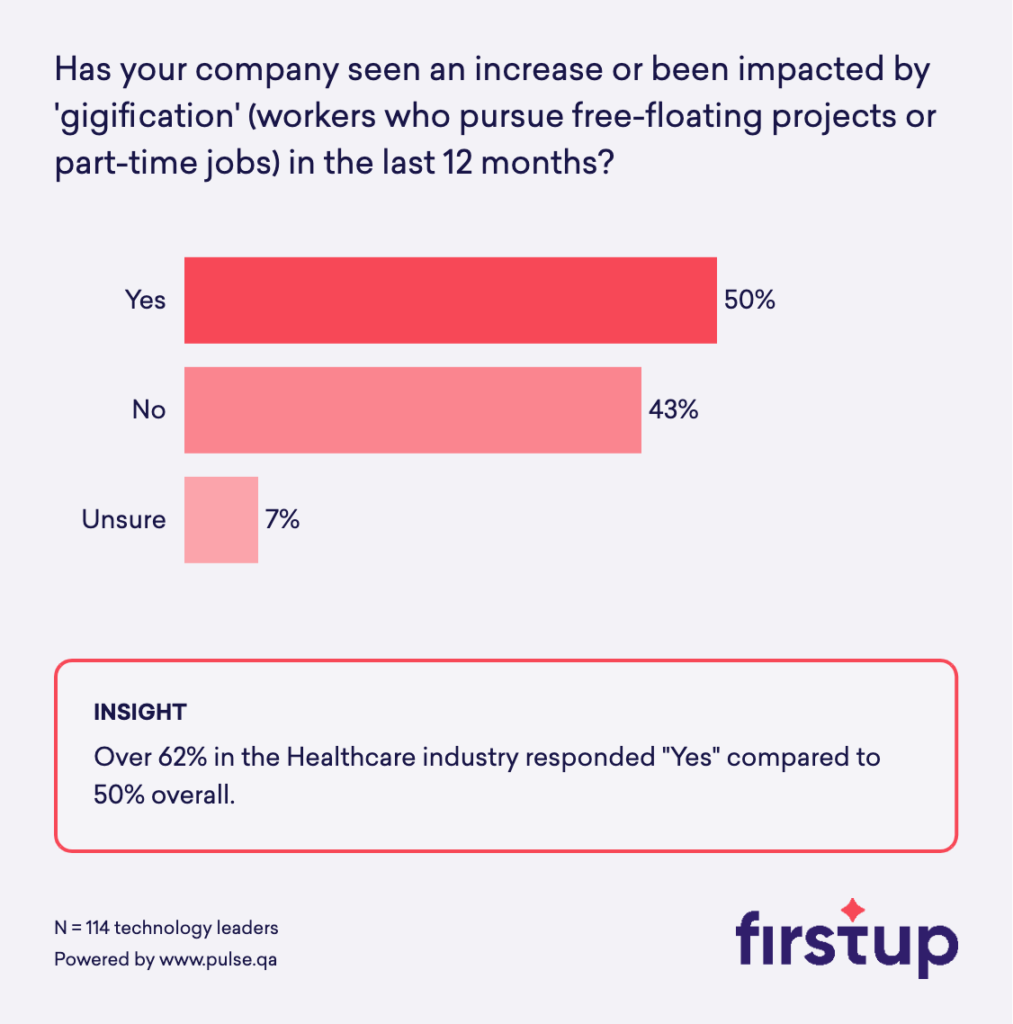Our very own Rupert Coghlan, along with Marc Wright, Founder of Simply Communicate and Olly Henderson, Founder of Future Work/Life recently caught up to discuss ‘gigification’ and to outline how business and communication processes need to adapt to cater to this growing trend. Below is a short insight into what was discussed and just some of the tips and advice are given. Watch the full conversation here.
Gigification is reshaping the workforce
Firstup recently commissioned the global gigification research with over 23,000 participants and the results highlighted that this new way of working is gathering pace.
Key findings from the research were that 1 in 3 people felt that they are not being recognized within their own companies and 20% of staff felt that if they went on holiday, they were not being recognized either. While 88% of those surveyed said they felt a need to improve their work-life balance. The trends being seen are that employees need to hear more from their leadership and want to have more targeted communications but on their own terms.
At the moment a lot of job hunters are filtering out those companies that are not offering ‘remote working’. Work-life fit is coming first in terms of priority followed by salary when employees are asked what is most important to them in a job role; so, as Ollie Henderson highlights, companies will ultimately be paying more money and seeing less of their staff!
But by doing this, these businesses will be empowering their employees and also demonstrating their trust in them to do the job that they are being paid to do. The best companies are doing exactly this right now and leading from the front, showing just how important culture is to them. However, as the panel discussed, this is not without its problems.
Key challenges of gigification
Here are a few challenges facing the C-suite when accommodating gig workers:
- Increase of gig style workers—once they are employed, how do you retain them?
- The war for talent is a reality but not necessarily as competitive as some may think in particular job categories.
- We’re witnessing a time of massive wage inflation leading to an increase in costs.
- It’s becoming increasingly expensive to bring new people in.
- It’s increasingly difficult to introduce new hires to the organization’s culture rather than transform it for existing employees.
An important factor to remember or to at least think about is the term ‘work-life balance’ because it means different things to different people. Companies need to have the confidence to give their employees autonomy for designing their own work-life balance. They need to be able to trust their workforce, which in turn will give employees a sense of purpose within their role. As long as their goals are being met and work tasks are being delivered, in essence, workers should be trusted and allowed to do other things that will help them to strike this balance.
The importance of internal comms
One of the webinar poll questions highlighted the importance of having a robust internal communications strategy in place. But what can we include in these strategies to cater to all the different working environments that people want? Here are a few tips and suggestions from the webinar:
- Set expectations through a strong onboarding strategy—giving a new employee clear ideas of the company’s culture and sense of purpose straight away will help them to feel like they belong immediately.
- Make it easier for leaders to reach employees.
- Remove friction—make people’s lives easy by enabling them to receive relevant communications and be able to access important tools and tech as early, easily and quickly as possible.
- Embrace analytics—you will be able to measure success and develop a sound understanding of how many people resonate with your communications. This will then enable you to forecast where and when is best to deliver messages or if people have already been saturated with too many on a given day or week.
- At the end of the day, actions speak louder than words. So it’s all very well saying all this and promising it all to your employees but companies need to make it actually happen as well, and quickly.
Pre-boarding and onboarding
Pre-boarding and onboarding experiences form a significant part of retaining new staff.
An individual needs to feel their worth from the outset of joining your organization. New employees need to be made familiar with their new company culture as soon as possible, this is particularly important for ‘gig’ workers who may not have the time to interact with others regularly. Good pre and onboarding strategies have a great long-term effect and encourage employees to stay with a company for a longer period of time. Some advice below that came from the experts during the webinar;
- Get in touch with new employees at least a week before they actually start their role and ease them into the company culture with a bit of pre-boarding information.
- Have a campaign logic so you can identify employees that have joined in the first 30 days—for example, give them five new things to work on each per week.
- Encourage them to take part in certain channels relevant to their work, area they live or interests and give them nudges to take part.
- Teach each individual what their role is within the job opportunity and the new company they are going to be working for.
- Assign a buddy outside of the team or a manager so their experience becomes more about culture and understanding of how the organization works.
- Crowdsource ideas from other employees that have recently been onboarded to improve the experience.
- Give new employees a list of terms and jargon. Every company has its own terms and language – it’s inevitable but a great place to start.
At the end of the day, everyone remembers good and bad onboarding experiences. Just make sure your company offers a good one!
Watch the full webinar, available on-demand.
Download PDF









